Sponsored by Battle Quest Comics
By Brian Hibbs
[Editor’s note: we are aware of the divisive nature of the word floppies, it is used with Brian’s permission here in the headline.]
You will, I hope, recall that last column I discussed the changing discounts that retailers are facing for periodical comics? Well, apparently I wrote too fast because (naturally!) within a month of writing that piece, DC’s sole periodical distributor, Lunar, who is owned by every US retailer’s number one competitor for periodicals (Discount Comic Book Services), switched from the “grandfathered” discounts to new “calculated” discounts. Under the new scheme, your discount is based on the total volume you purchase from Lunar. When all periodicals were purchased from a single distributor, this kind of plan made a sort-of sense – but in a world where there are (at least) three different distributors and our volumes are inherently split, I believe this to be an entirely irrational way to sell them.
So as to not bury the lede: I dropped from an I‘ve-had-it-for-thirty-three-years 55% discount on DC from Lunar down to a 50% base discount. After shipping, this then works out to an effective 46.8%. This therefore means that A) DC comics are now the worst discount of my three largest periodical vendors (Marvel’s effective discount is 50%, Image’s is 47.2%); and B) selling periodicals from DC comics are now a roughly break-even possibility with very little room to make any kind of a profit. Those single percentage points are where pretty much all of the profit are in selling Periodicals.
I am pretty certain that my overall DC volume is in the upper quintile of all Direct Market stores, but I have purchased my Perennial DC stock from Penguin Random House since around 2016 not only as a way to avoid all wasted shipping charges (PRH charges no shipping on any shipment), but also because PRH has consistently had a greater amount of DC Perennial backlist stock than either Diamond or Lunar, and we are a Perennial backlist-focused store. But, because Lunar only calculates discounts from what I purchase from them (as opposed to what I purchase from DC), none of those sales “count”.
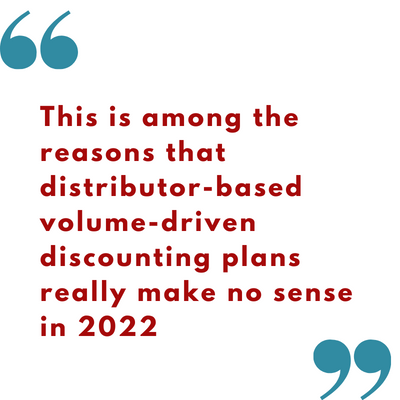
That is to say that I could perhaps move every Perennial DC item to Lunar today (taking a drop from 50% from PRH to 46.8% at Lunar), but my actual live discount couldn’t be impacted until January of 2023. Thus, if I wanted to try that, I’d have to lose most of my Perennial Item DC profit for six months. This would be, shall we say, sheer Lunacy.
And, please, it is critical for you to understand that Lunar has pretty mediocre stock of DC Perennial backlist on hand. This is because Lunar is not actually a proper full-line distributor in practice, but, rather, appears to be stocking backlist inventory based on how it sells at their other direct-to-consumer outlet, In-Stock Trades.
The notion that the roughly three thousand independent comic book stores would have to sole source all DC purchases through their largest consumer-discount competitor is, frankly, sheer madness, if not marginally criminal. Each and every extra penny that goes to Lunar’s parent does little else but fund our own competitor.
As I say: Lunacy.
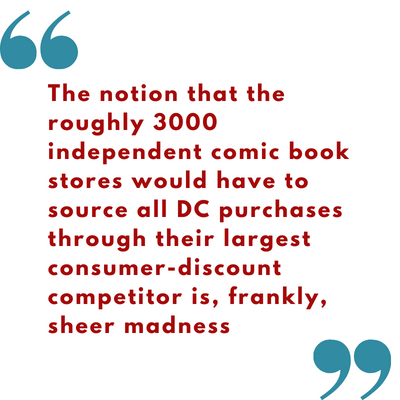
The inevitable outcome of this can only to be to tighten my rack purchases of periodical comics from any vendor where I can’t get at least an effective 50% discount. And, sadly, this pretty much means minimizing purchases for the rack on periodicals.
Let’s take a few steps back to consider the inherent maths of periodical comics. Periodical comics allow publishers to amortize the costs of creation via that serialization, and, in a best-case scenario make it so that all creative costs are wholly paid for making the Perennial backlist editions effectively “free” from creative costs to produce. Without this life cycle, you’re much more likely to see lower-page count books that are then released as $25-30 hardcovers versus $15-20 paperbacks. The inherent risk, for publisher, for creator, for retailer all scales up significantly at this point: it is significantly easier to sell a $3.99 serialization than it is a $24.99 hardcover for the overwhelming majority of material published today – often by as much as a ten-fold difference in audience size in the first year!
Further, the sheer existence of periodical serialization creates both a regular and ongoing material incentive for timely production of content (because everyone is getting paid during the serialization itself) as well as long-term marketing and awareness benefits as a title is out on the market month-after-month. These are things that not only should not be understated, but that drive almost all of the proper viability of long-term success in comics. Most of the creators who are able to make a steady and regular living in comics are able to do so because of the viability of serialization.

On my side of the counter, periodicals are the items that bring in cash flow, impel regulars to return, and give us an easy-to-use Fresh Conversation every week. The audience for most periodicals is broadly significantly larger than the audience than the audience for that same material in a book format, and the periodical buyer is the most likely to buy the material again in book format, because they are the “super fan”. It’s a viable economic engine, as long as the market is properly maintained.
All of this makes me think that it is therefore extremely dangerous for the larger health of the underlying market to weaken the viability of the periodical serialization. Because when retailers can’t make a meaningful profit on those periodicals, it upsets the entire applecart. Not simply from what we buy upfront, but from what we both signal and learn about a title’s market viability – there are innumerable titles that I figured out the market after I sold the periodical that I otherwise would have written off; similarly I’ve avoided several costly mistakes on a book format item by having the serialization show me the true audience.
I don’t think that it’s really hyperbolic to say that the publishing business of DC and Marvel (and every other “Direct Market” publisher) is literally built around serialization, so changing the cost structure to the retailer’s disadvantage is inevitably going to bring more conservative ordering. How can it not? Unless I’ve been given the ability to make a viable profit, I can only order to the “safest” sales model. For some stores, that has become the strong lean-in to “collectibles”, the variant cover and other stunts where they can increase margin in that fashion; other stores have shifted to models where they are increasingly less “comics” stores, but are as much game or card or pop culture stores.
At the end of the day the Direct Market store I believe is pound-for-pound always going to be better than selling comics related material than a generalist business like a book store; I don’t think it’s going to be even close. But here’s the problem: anything less than a minimum of “keystoning” (a doubling of investment) makes retail nearly impossible to do and make a profit – certainly the “traditional” book market understands that, where I can get 50% off and free shipping from virtually each and every “Big Five” book source – and I hold it as a bedrock axiom that a specialist retailer like DM stores carrying periodical comics should be earning better than that. It’s why we have a multiple decade history of earning 55% off for most dedicated DM stores on the largest publishers. But that’s all going away; and it is entirely unviable. Publishers should be falling all over themselves to make sure that any “full line” store can always do better than merely “keystone” the core merchandise. To not do this? Well, I think it actively destroys the category of periodical releases.
Let me tie this to recent news about two promotional efforts recently announced: first off, Mark Millar’s new comic, “Night Club” has announced a price point of $1.99 for that mini-series. Second Frank Miller’s new publishing venture is launching with a $1 “ashcan”. This all sounds promising from a news and marketing point, but when I look at my average cost to bring in those comics over the last five weeks, my per-item average is currently coming out to nearly fifty-one cents. So, this includes graphic novels from Diamond (but, really, not all that many these days!), so maybe it’s actually running closer to forty cents, but even the most basic math can only show you that it is unlikely that these can make any money for the stores whatsoever – heck for the Frank Miller thing, after Diamond’s “reorder penalty” and usurious shipping, I estimate I can only make 2 cents selling it for the “cover price”. That doesn’t pay my rent or electricity costs, let alone staffing and labor! I’m certainly not going to order any of either of these comics to sell on my rack when I can’t make money selling them.
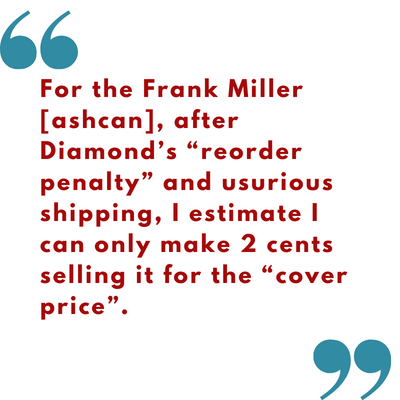
Comix Experience just celebrated a third of a century in business (!), and up until this year I thought it would be trivial to keep this going to hit the centennial, and convert the store to a worker-owned business when I am finally ready to retire. I don’t think this any longer.
I didn’t leave periodical comics. Periodical comics are leaving me.
**************************
Brian Hibbs has owned and operated Comix Experience in San Francisco since 1989, was a founding member of the Board of Directors of ComicsPRO, has sat on the Board of the Comic Book Legal Defense Fund, and has been an Eisner Award judge. Feel free to e-mail him with any comments. You can purchase two collections of the first Tilting at Windmills (originally serialized in Comics Retailer magazine) published by IDW Publishing, as well as find an archive of pre-CBR installments right here. Brian is also available to consult for your publishing or retailing program.
Sponsored by Battle Quest Comics


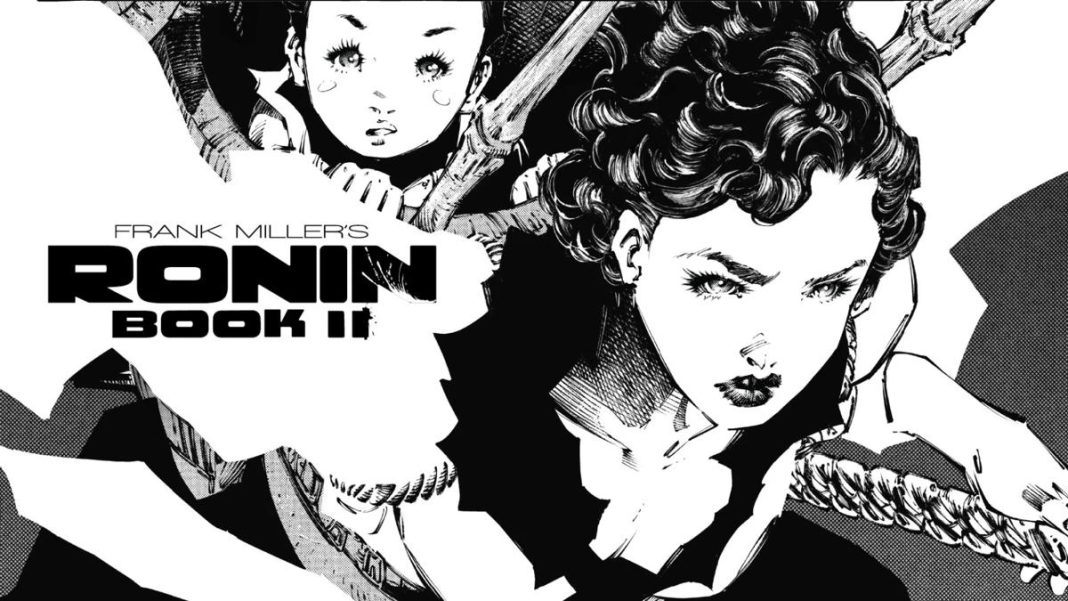


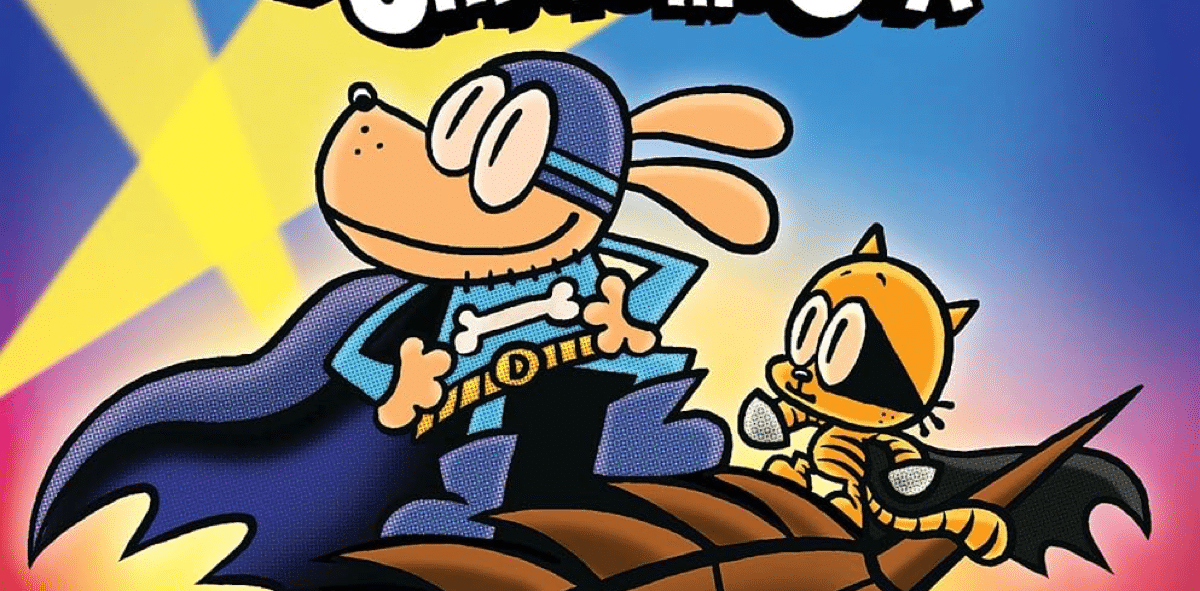
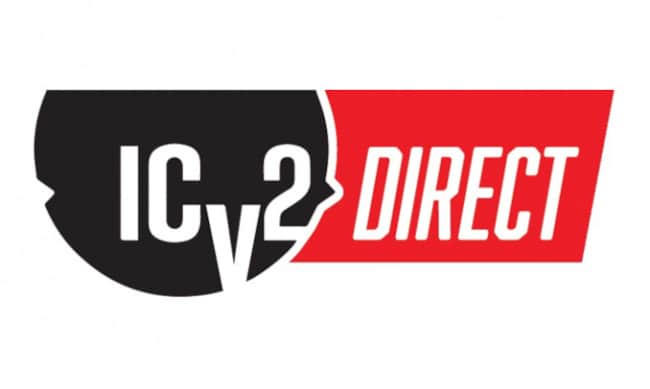


I totally approved the click-baity use of “floppies” in the title!
GOSH, do I hate that term, however!
-B
Yes, indeed. We transitioned to a pop culture bookstore a few years back. We still carry comics, but all I could see in the future was a continual uphill battle. We’re in a heavily touristy downtown core and we’re currently making 5 times more on books than comics.
Batman and Detective , pretty much get us to 55% , but we are probably an exception. And Brian isn’t Tales of Wonder owned by Diamond. So what is the difference?
And Brian . how in the world , did you ok Floppies?
Tales of Wonder is also a part of Lunar/DCBS/InStockTrades.
Brian, I always enjoy reading your Tilting columns, not only informative but also entertaining. I speak now from the consumer point of view, and I agree with you that the comic book retailer business is no longer working as method of distribution of comic books or the collections (trades, hardcovers, omnibuses, etc.) of comic book stories. Let me relate this experience that I just had with a local retailer.
I live in the northern half of Ohio, where retailers are within a 30-minute drive of my home. I had visited one several months ago, and impulsively bought a trade paperback titled “Serial” which contained the first 5 issues of the comic book of the same name. Last week I visited the same store and among other things was looking for the 2nd trade collection which collected the final 5 issues of the story. The retailer was very polite and told me that he did not have it in stock, he quickly checked on line and reported that Diamond did not have it in stock either.
Later at home I did a check of eBay and found nothing there and, seeing that an omnibus was being published I realized that I was going to be out of luck.
Fortunately, I was able to order it directly from the publisher, but this was only because I was familiar with them and was aware that they could be a source. This is not always the case, and I believe it is more likely not a feasible option in most cases as many publishers do print over stock any more. I learned that its buyer beware.
My point to this fable is that consumer satisfaction is what keeps you guys in business, and that the comic shop business is not working due to things like this which I believe is due to inherit flaws in the business structure.
Also, it sounds like you are leaving the business (I do get the wordplay in the title), which I do not blame you, but I’m sure you will be sorely missed.
I’ve been saying for 30+ years (since I was a retailer, in fact) that the US comics business is unsupportable. The comics are too expensive and carry too little discount. For the most part it’s run by enthusiasts, and although there are circumstances in which they can succeed, usually it’s because they sell other items than comics. Compare this to Europe where most shops that carry comics make money from them. That’s because an Asterix graphic album costs 6.95 euros – about the same in dollars. But that’s for a 48 page graphic novel with a page size of 9.4×12.6 inches. It had a print run of 5 million copies. Not all Graphic albums sell that many copies, but they are priced to sell. In addition, there are usually other versions of the albums – collectables, hardcovers etc. Look at comics in Japan where it costs $1.99 to subscribe to Shonen jump digital every month with a backlog of tens of thousands of episodes. Yet people still queue up to buy the Tankobon paperbacks. There are even free manga digital outlets such as Shueisha’s MangaPlus which carries top line manga such as Chainsaw Man, One Piece, Monster 8. Yet still the printed volumes sell.
The problem in North America is the direct distribution and the falling sales figures due to it have made comics a prohibitively expensive form of entertainment compared to almost anything else. You can literally buy a subscription to something like Crunchyroll for the cost of two US comics. For that you get the anime library plus the manga app (although you might not want to – it’s awful). I just don’t think you can sell comics at the price they are to a big enough audience to make the figures make sense for a commercial business. All comics publishers need to take a hard look at how they can compete. Given that Webtoon will give you pretty much endless entertainment for nothing, betting on the idea you will buy coins to read stuff earlier than you can for free, and that DC Comics Batman and Zatanna are on that platform, it’s hard to see so long a completely artificial market that’s dependent on ageing fans can keep going.
@Peter Mann, I disagree with most of that — the audience for serialized comics for adults is significantly larger than the audience for that same material in book form, in most cases. The issues of declining sales figures have far far far more to do with overproduction by Marvel and DC of their most popular characters, and by the hard lean into “fake collectibles” like Variant covers which confuse and turn off the casual reader.
Further, platforms that are “free” like Webtoon mean that the overwhelming majority of content creators are never able to earn monetization and are therefore working 100% for free. I personally like it when people can build long-term careers where they can earn something approaching a middle class income, without giving away all of the fruits of their labors for zero return.
In many European markets there are actual laws about maintaining the cover price (no discounting allowed!), while in Japan they’re much much more of a commuter culture on public transportation than any American consumer could dream of.
@Rick Hood: Uh, no, I’m not leaving comics. What?
-B
Interesting.
Hello,
My personal experience of comics has been more intermittent rrader to omnibus buyer. I could go years without buying a single issue because there was nothing from DC to motivate me to go to my LCS. It took a YouTube video about a videogame’s approach to a favorite comoc matchup that spurred me to take a risk on New 52, and I have been a buyer ever since.
My perspective as a quantitative research analyst has formed a perspective that DC had transitioned from an IP generating firm into an IP preservation firm almost 2 decades ago with the arrival of DiDio. As he became more powerful in the company, the use of gimmicks became more widespread. The reason for the gimmicks became clear while reading “The Economics of Digital Comics” by Todd Allen. The overall audience of the direct market is static and the median age and buyer income are increasing. Using Comichron’s annual sales figures and market share data, the dollar sales of DC lines up with the overall direct market as nearly fixed with national income growth–a sign of a healthy developed market if the products themselves are similar over the interval. The instability is the increasing concentration of sales gimmicks to make those sales numbers.
ComicHub’s rankings at ICv2 gives a story that outside of Batman, DC is effectively dead to customers. The breaking of the Diamond monopoly has caused an increase in conservatism for retailers that is covered by even more gimmicks. This leads to three crossover points:
The GN channel has had higher secular sales growth for the last 15 years in genres outside of superhero comics, per your own sales analysis. Those sales to the book channel are more profitable on trades & GNs that have already recouped their costs in the direct market per your column.
The product that DC sells in comic shops does not translate to other media as well as the stories pre 2000s, leading to a vicious cycle that results in manga/anime synergies dominating trade sales & seizing the future readers from the main direct market publishers.
The audience for western comics in 2016 was older and less diverse than the audience for mainstream superhero comics, per an article from the Beat. The growth in creator owned trades is likely more from readers being turned off by the big 2 and switching than new buyers coming in, despite the surge in popularity for adaptation linked titles like “Invincible” and “The Boys.”
*4. Diamond Distributors may not be viable as a distributor in the long run with current offerings being so small relative to PRH & Lunar. This makes the likely equilibrium a shift to PRH & a new monopoly that does not even need comic sales for their main profit model.
The conclusion I see is that DC is moving into a crisis of its own making that could damage the overall viability of the entire US Comic industry. The sales figures of the DC Webtoon initiative could be a nice venture idea, but it is too “profit tomorrow” to replace the cash flow benefits of the direct market. All of this would be different if Marvel/DC put out regular cartoon content that matched the steadiness in their monthly comics:: which is impossible given the documented unpopularity of their monthly storylines with the audience they actually have beyond habit.
@Melvin: This was an extremely thoughtful response, and one I don’t have the time to respond to properly today, because it requires an as in-depth answer, but I will say that I think in a few cases you’re mistaking chickens for eggs, or saying that effects are actually causes. I’ve made some notes for a possible future column, however!
Comments are closed.